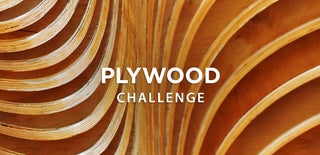Introduction: Carved Plywood Rocking Elephant
Inspired by a picture of a plywood elephant with leather ears that I found online, my business partner and I took on the project of making an adult size rocking Elephant for a friend who is a kid at heart. We went on to make two more toddler sized ones, the last of which is pictured here.
Update: While I wasn't aware of the original creator at the time, I've been referred to the artist of the inspiration piece. He is James Harvey, and this is his site: http://rockingrhinos.com/ Check out his other animals too, quite the artist!
Supplies
Toddler size version:
1/4" Indonesian Birch Plywood for the body
3/8" Baltic Birch Plywood for the rockers
4/4 Maple Hardwood for the rocker cross-beams
Wood Glue
Adult size version (scale the provided art to 200%):
1/2" Indonesian Birch Plywood for the body
3/4" Baltic Birch Plywood for the rockers
4/4 Maple Hardwood for the rocker cross-beams
Wood Glue
Step 1: Slice a 3D Model and Laser Cut the Base Parts
We began with a purchased 3D model that could be manipulated to align the legs to something more rocking-horse-like. That was sliced in Fusion 360 Slicer and laser cut in plywood, first as solid pieces, but after gluing the body together and struggling to get it off the table because it weighed so much, we re-cut it with hollow parts.
UPDATE: I've added my cut file for the toddler size version in Illustrator editable PDF format, licensed CC BY-NC-SA 4.0. It's setup for 48x60" pieces of 1/4" Baltic Birch Plywood. I included a few notes, but it's not meant to be a How-to document. For an adult size version, scale the art to 200% size and cut from 1/2" plywood.
Attachments
Step 2: Glue Up the Layers
The slicing software placed alignment holes and numbered the parts. Those were used for gluing each layer together. We glued it in halves to make the sculpting easier. Clamping such an irregular shape is super challenging!
Step 3: Grinding
Using Kutzall brand carving discs in an angle grinder, we roughed out the shape. In principal, it was simple... grind away wood until the black laser cut edge is gone, but in practice, it required visualizing the shape you wanted and how it fit with the contours created by the layers. A lot of material was removed and the room was covered in sawdust.
Step 4: Join the Sections and Continue Grinding
We worked in halves and did the ears separately so it was easier to maneuver, but it was still challenging getting the grinder into all the nooks and crannies. And when we did join the sections together, there was still additional grinding to make the joints come together. Although rough, it was starting to look like our vision!
Step 5: Sanding
After course grinding, we cleaned up the contours with days of sanding with every variation of sander we could buy. Random orbital was too slow. A sanding disc on the grinder was super efficient but hard on the discs. Needle/strip sander worked ok. Hand sanding some areas was a must. But gradually, it came together.
Step 6: Adding the Rockers
We didn't have a good sense of what shape the rockers should be to allow good rocking, but avoiding the risk of turning the whole thing over. Many cardboard test pieces were cut and tested before committing to three layers each of plywood. Two layers were glued, then screwed to cross bars of solid Maple hardwood that were bolted to the feet. The last layer hid the bolts and a coat of paint (or stain on later versions) added the finishing touches. We finished the elephant with boiled linseed oil. Acrylic half spheres with a printed eye were installed. Then it was packed on a pallet to go to its new home.
Step 7: At Home in the Playroom!
After a safe journey, it found its new home among friends.
Step 8: Version 2
After the long, sweaty, dirty "trauma" of the first one wore off, I decided to do an actual toddler sized one for my nephews. This one was both easier and more difficult. It was half scale, cut from 1/4" Baltic Birch plywood. The higher quality plywood was better because it didn't have as many voids as the Indonesian Plywood had (but Baltic Birch is 5x5 sheets and wouldn't have been as efficient for the larger size). It was basically 1/4 of the volume of the other one so grinding and sanding was shorter, but being smaller, many of our tools didn't fit in the narrow areas, and thus we bought more tools and grinders. But applying what we learned the first time, it came out even better.
Step 9: Version 3
We live in an apartment attached to our company, so when we were shutdown for COVID, we decided to spend the time making one as a gift for an important client. While no less work, we were reasonably well practiced now, so this one came out the best so far. While it will likely never be viable as a product for sale, it is definitely a statement piece that is valued by those who receive it as a gift.

Grand Prize in the
Plywood Challenge









